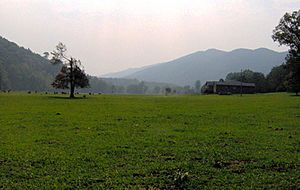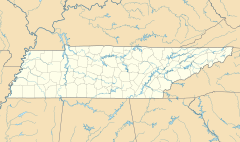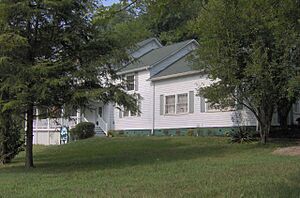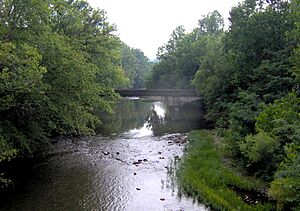Walland, Tennessee facts for kids
Quick facts for kids
Walland
|
|
|---|---|

Miller's Cove, with Chilhowee Mountain on right
|
|
| Country | United States |
| State | Tennessee |
| County | Blount |
| Settled | 1780s |
| Named for | Walton and England Leather Company |
| Area | |
| • Total | 1.52 sq mi (3.95 km2) |
| • Land | 1.52 sq mi (3.95 km2) |
| • Water | 0.00 sq mi (0.00 km2) |
| Elevation | 1,034 ft (315 m) |
| Population
(2020)
|
|
| • Total | 281 |
| • Density | 184.26/sq mi (71.16/km2) |
| Time zone | UTC-5 (Eastern (EST)) |
| • Summer (DST) | UTC-4 (EDT) |
| ZIP code |
37886
|
| Area code(s) | 865 |
| GNIS feature ID | 2586084 |
Walland is a small community in Blount County, Tennessee. It's known as a census-designated place (CDP), which means it's an area identified by the U.S. Census Bureau for statistical purposes. In 2020, about 281 people lived there. Walland has its own post office and is linked to the zip code 37886. This zip code actually covers a larger area than just the Walland community itself.
Contents
History of Walland
Early Days in Walland
Long ago, in October 1567, a Spanish explorer named Juan Pardo and his team likely traveled through what is now Walland. They came from the east and headed west, crossing part of Chilhowee Mountain. This area, known as Miller's Cove, was once a large hunting ground for the Cherokee people.
When the first European-American settlers arrived in the 1780s, they were drawn to Miller's Cove. The land was fertile, and important Native American trails passed nearby. These trails connected to other Cherokee villages like Chilhowee and Tallassee.
Settlers started building homes in Blount County around 1785. This was a time of some tension with the Cherokee. To stay safe, the pioneers built small forts. Miller's Cove is probably named after Alexander and Andrew Miller, who built cabins there around 1800. Other early settlers included John Hess, who built a gristmill (a mill for grinding grain) and the Martin family, who also had a mill.
In 1810, the Miller's Cove Baptist Church was formed. It is still one of the oldest churches in Blount County today.
Walland During the Civil War
In 1845, a man named George Amerine built an iron forge in Miller's Cove. A forge is a place where metal is heated and shaped. His forge made about 15 tons of bar iron each year. However, when the Civil War began, the forge stopped working.
Blount County was a strong supporter of ending slavery, known as abolitionism. This was partly due to people like Rev. Isaac Anderson from Maryville College. When Tennessee voted to leave the Union in 1861, most people in Blount County voted against it.
Miller's Cove also supported the Union. In 1861, Union supporters held a rally there. They raised an American flag and promised to stay loyal to the United States. Later, when Confederate soldiers passed through, a local judge warned them not to touch the flag. He said the mountains were full of Union supporters who were good with rifles. The soldiers listened, saluted the flag, and moved on.
Growth and Change: 1890 to 1931
In 1893, a company from Philadelphia called Walton and England Leather Co. looked for places to build a tannery. A tannery is a factory that turns animal hides into leather. They chose Miller's Cove because it had many trees, and tree bark was used in the tanning process.
The company built a small town around the tannery. They named the town Walland, combining "Walton" and "England." The house of A.J. Fisher, who managed the tannery, is still standing and is a historic site.
In 1901, the Schlosser Leather Company started an even bigger tannery project. They used bark from trees in the Little River valley. By 1909, their tannery was processing 300 hides every day! This brought modern things to Walland, like electricity, new houses, and better access to the railroad. The company even built the Chilhowee Inn in 1902 for visiting executives. They also helped finish Walland High School in 1922.
The Schlosser tannery burned down in 1931 and stopped operating. But Walland found a new way to grow: tourism! The Great Smokies were nearby. The Little River Railroad, originally for logging, started carrying passengers to the mountains by 1909.
Many resorts opened near Miller's Cove, attracting tourists with mountain springs. With the creation of the Great Smoky Mountains National Park in 1934 and the building of US-321, Walland became a popular stop for tourists. This helped the town recover from the loss of the tannery jobs.
In 1966, a part of the Foothills Parkway was finished, connecting Walland to Chilhowee Lake. Another section, linking Walland to Wears Valley, opened in 2018.
Geography of Walland
Walland is located in a special type of valley called Miller's Cove. This valley is surrounded by hills and mountains. To the north is Chilhowee Mountain, a long, low ridge. To the southwest and southeast, Hurricane Mountain and Bates Mountain separate Miller's Cove from another large valley called Tuckaleechee Cove.
The Little River flows through Miller's Cove. It starts high up on Clingmans Dome and divides the cove into two parts. The river's valley has always been an important path for trails and roads connecting the mountain coves. Today, U.S. Route 321 follows this path, linking Interstate 40 to the Great Smoky Mountains National Park. The park boundary is about 15 miles south of Walland.
Population Information
| Historical population | |||
|---|---|---|---|
| Census | Pop. | %± | |
| 2010 | 259 | — | |
| 2020 | 281 | 8.5% | |
| U.S. Decennial Census | |||
According to the 2000 census, about 3,746 people lived in the larger area covered by Walland's zip code (37886). Most of the people were White (97%).
About 30.5% of homes had children under 18 living there. Most households (65%) were married couples living together. The average household had 2.49 people. The median age of people in the area was 39.3 years old. The population was split evenly, with 50% male and 50% female.
The average income for a household in the area was $40,000. About 9.2% of families and 12.4% of the population lived below the poverty line.
Schools in Walland
Walland has one public school: Walland Elementary School. It is part of the Blount County Schools system. The school building was built in the 1960s. It used to be a middle school and a high school. The school also has a bookmobile that brings books to the community.
Before it closed in the mid-1970s, Walland High School won a state championship in football in 1975. They beat White House with a score of 22-6.
Images for kids
See also
 In Spanish: Walland (Tennessee) para niños
In Spanish: Walland (Tennessee) para niños






